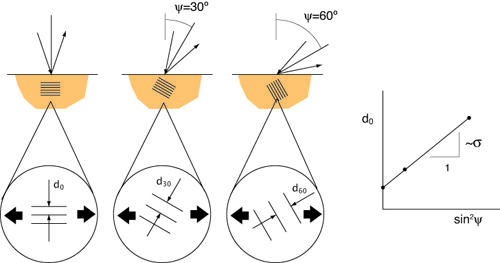Summary
Using X-ray diffraction techniques one can measure the full stress tensor just inside the surface of a sheet metal specimen under applied load. For experiments that deform the material in plane stress, the through thickness stress is assumed to be zero after yield, which allows the average macro-scale stress to be derived from the surface stress measurement. This permits the measurement of biaxial stress states resulting from directly applied strains or resulting from features, such as a hole or localized neck. Measurements can be made even when the test method cannot measure the stress directly, due to unquantifiable friction (Marciniak testing) or complex specimen designs (cruciform testing). These are cases where determination of stress by the uniaxial load divided by current area assumptions breakdown, and often require numerical modeling and an assumed constitutive law to interpret the results.
Description
X-ray diffraction is commonly used to measure a materials crystal structure, crystal lattice orientation, and the spacing of the lattice planes. Our X-ray systems are designed to measure the spacing of one or two specifically selected lattice plane reflections for a given material. The systems use various X-ray tubes selected to optimize these measurements for ferritic steel, stainless steel, aluminum, or magnesium alloys. The system tracks the lattice spacing from the initial to current spacing while the specimen is under applied load in the plane of the sheet. By tilting the measurement system from the normal direction of the sheet toward the direction of loading the distribution of strains can be measured and used to derive the full stress tensor just inside the sheet surface.

We use this method to measure the average stress for plane-stress experiments in the plastic range while the specimen are held under load. The two systems are associated with our Marciniak and cruciform mechanical testing machines which can apply plane-stress in fixed and variable stress ratios, respectively, between the principal axes of the sheet material. The measurements are made at a point typically between 0.5 mm to 3 mm in diameter, and can be repositioned to interrogate multiple points on the specimen surface. This permits measurements of the multiaxial stress field around features (e.g. hole or localized neck) in the specimen.

